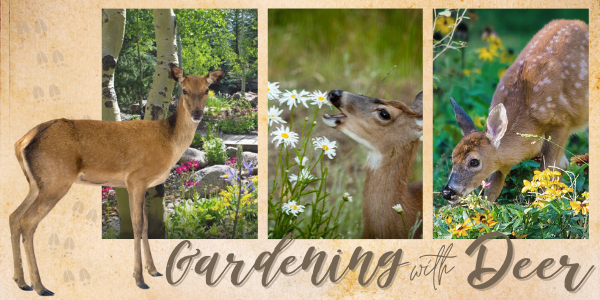Each summer we get questions from exasperated gardeners asking, “What can I plant that the deer won’t eat?” It’s a complicated subject, since what works for one gardener might not work for another. However, there are a few smart garden strategies that you can try that may make your garden less attractive to deer.
MAKE SMART PLANT CHOICES
Your first line of defense is always to make smart plant choices. Be aware of plants deer favor, and make sure you’re not stocking your garden with a buffet of their favorites! Armed with a little information, you may be able to plant your solution to the deer problem and discourage them naturally.
Deer tend to like plants that are smooth, tender, and flavorful. Plants such as arborvitae, tulips, hosta, daylilies, and roses are favorites. What they do not like are plants that are highly aromatic, prickly, thorny, fuzzy, or plants that contain a milky sap like milkweed. They also naturally avoid plants that are toxic such as foxglove, daffodils and poppies.
So, what types of plants are deer resistant? Some good shrub choices are: Holly, Barberry, Spirea, Boxwood, and Lilac. For the herb and vegetable garden try: onions, garlic, sage, tarragon, lavender, mint, and rosemary. Deer-resistant flowering plants include: Peony, Marigolds, Forget-me-not, Bee Balm, and Iris. Ornamental grasses in general are not a favorite of deer, but within that category try planting Blue Fescue, Golden Hakone grass, or a Black Mondo grass
As for that elusive deer-proof plant — there is no single plant that is guaranteed to be completely “deer proof!” As Dr. James Klett, Professor of Horticulture and Landscape Architecture at Colorado State University states, “Deer — if they’re hungry enough — are going to eat anything. If there is a completely deer-resistant plant out there, I don’t know what it is.”
TRY STRATEGIC PLANTING
If you think in terms of which plants deer do and don’t prefer, you can begin to plan your garden with a bit more foresight and strategy. Since deer tend to be skittish about coming in close to a living area & would rather remain near the safety of the forest, try planting your deer-favorite plants (like tulips and roses) close to the house. Also, planting less-preferred plants in a protective ring around those that are more desirable can be an effective strategy.
Another deer-repelling strategy you can try is to “foul the fringes” — that is, line the perimeter of your property with unpalatable plants. Strategically placed hedges or thorny shrubs can serve as a natural way to redirect the deer and discourage lingering to feed on more attractive plants nearer to your home. Clever!
OBSCURE THEIR VIEW
Deer don’t go past anything they can’t see through or over. You can make that work in your favor. Use solid hedges of pungent junipers or form trellises with fragrant morning glories. If deer can’t see what’s inside, they’re less likely to take that leap of faith onto your property.
MAKE THEM A TASTIER OFFER
Try working with their favorite plants combined with their desire to stay near the safety of their forest home. Plant things they DO like well away from your garden. A feast of their favorite flowers (delphinium, phlox, hosta and pansy) may have them nibbling, then heading safely back into the forest. It can be your sacrificial garden. The idea is to leave them thinking, “Why brave the garden close to the house, when the good stuff is planted all the way out here?“
Keep in mind that deer are like people, and what deters one won’t always deter another, but trying several of these strategies can help. With a little careful planning, and a few tricks here and there, it may be possible for your garden to coexist peacefully with these beautiful creatures!
